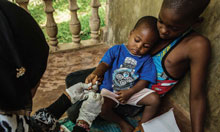
Understanding what causes anemia is critical to design effective programs and monitor impact. At the beginning of July, the Biomarkers Reflecting Inflammation and Nutritional Determinants of Anemia (BRINDA) Project published a supplement in the American Journal of Clinical Nutrition that presents approaches to better estimate micronutrient deficiencies and identifies risk factors for anemia from countries around the world.
To help bridge the gap between research and practice, SPRING developed a brief on the programmatic implications of the BRINDA findings. This brief is intended to provide guidance for policymakers and programmers involved in planning or interpreting results from a survey that measures anemia or micronutrient deficiencies, as well as for those designing and implementing programs aimed at reducing anemia .
Following the success of the first phase of the BRINDA Project, a second phase is underway to improve nutrition assessment and characterize the double burden of malnutrition.
To read about the programmatic implications of the BRINDA findings, view the brief.
